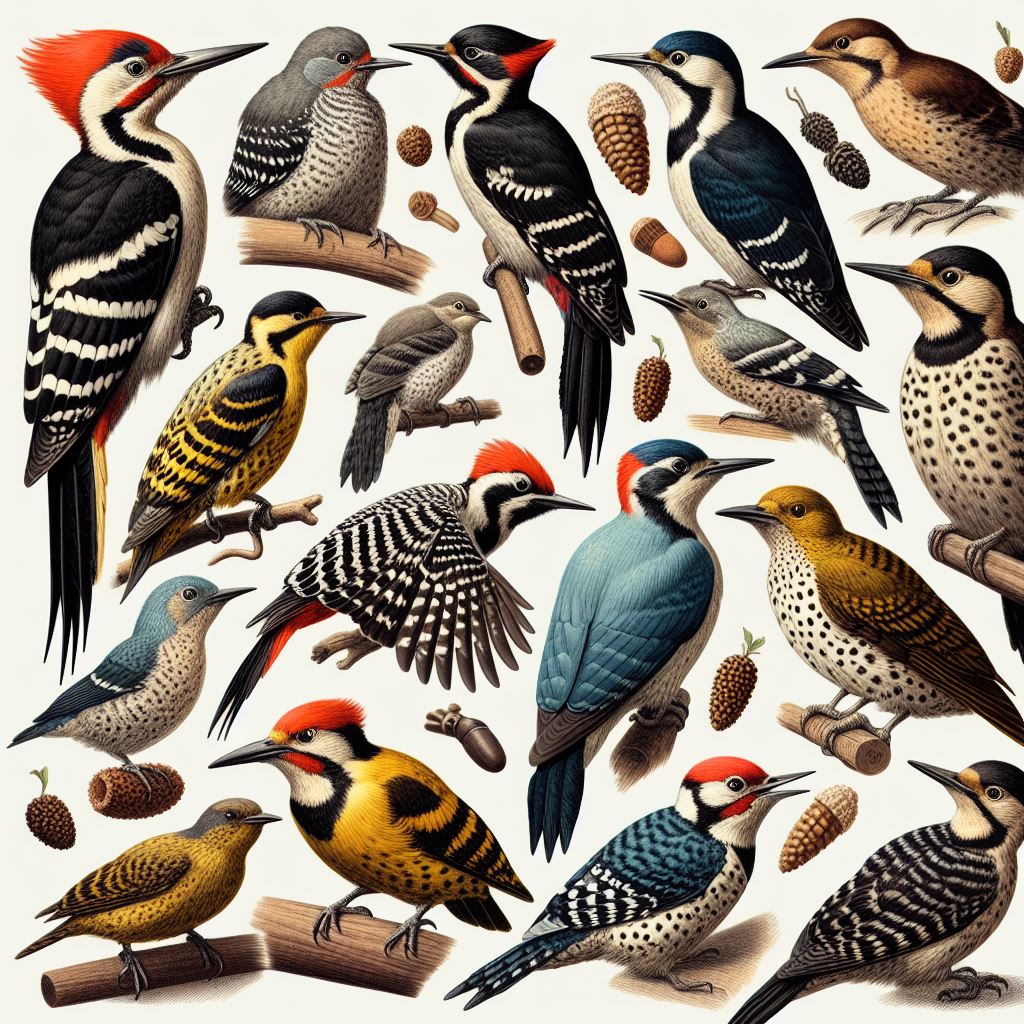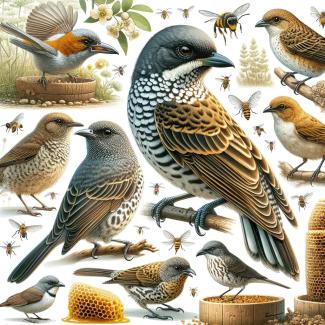
Containing woodpeckers, toucans, jacamars, and other arboreal insectivores, Piciformes represents an ecologically diverse order of strong-billed species well adapted to sustained climbing and excavation abilities facilitating exploitation of forest niches worldwide. With over 450 extant species across 5 primary families, they possess a near-global distribution - save frigid Boreal forests and Polar Regions lacking wooded habitats needed to sustain their characteristic lifestyle centered upon timing wood fibers for larvae and constructing durable cavity nest sites.
The early evolutionary origins of ancestral Piciforme stock trace back to nimble stem group picid-like birds probing the understories of Paleocene forests amidst early passeriform and coraciiform connections nearly 60 million years ago. From this early burst of scansorial experimentation later diverged modern crown groups like toucans and woodpeckers whose physical tools integrated advancing perceptual acuities suited towards extracting hidden nutrients across the wooded landscapes that came to dominate most global terrains during the Eocene climate optima.
Today's diversity showcases extraordinary specialization spanning tiny barbets to huge pileated woodpeckers - each finding success by subdividing forest microhabitats further and further by subtle differences in prey size preferences, foraging behaviors, nest hole architecture engineering or acoustic communication capacities that minimize unnecessary niche competition across shared habitats hosting these masterful carpenters worldwide.
Characteristics
Physical Features
Piciformes range dramatically in size and outward form - from tiny 8-centimeter barbets to huge 60-centimeter toucans bearing bills longer than their body length. However, most species share a stocky profile with a condensed tail and short neck transitioning towards a large blocky head.
This supports enlarged jaw muscles and ligaments facilitating relentless gripping strength and recoil resilience accommodating the battering forces sustained regularly against sturdy wood fibers.ANY specialized claws prove equally essential assets. Two toes face forward with two reversed in zygodactyl fashion to evenly brace substantial weight against vertical substrates.
Sharply tapering bills align impact forces through focal points while chisel or awl-shaped tips concentrate splintering forces cracking into concealed chambers. Heat exchange vascular adaptations insulate sensitive brain tissues from resonance vibration waves induced by relentless hammering behaviors.
Plumage patterns tend towards disruptive streaks and bars diffusing body outlines across bark backdrops. Such refined anatomical assets manifest as exquisite carpentry suits tailored towards excavating fortress homes amidst the most challenging building materials on earth through masterful evolutionary design processes across Piciformes lineages worldwide.
Behavioral Traits
Primarily insectivorous but supplemented by tree sap or fruits across lineages, Piciformes utilize strong bills equipped with gripping force facilitating excavating into woody substrates underlying bark to extract larvae and beetles from otherwise impenetrable chambers.
Such skills provide valuable ecosystem services increasing rates of dead tree decomposition and nutrient recycling back into soils. Scaly tongues with barbed tips also assist in capturing active prey like ants deep within miniature tunnels. Toucans supplement dedicated insect tracking with abundant forest fruits as well.
Reproduction and Lifespan
Mated pairs establish breeding status through acoustic displays before seeking nesting cavities, whether naturally occurring or freshly carved hollows shaped by prolonged hammering efforts from determined individuals establishing new den sites. The average clutch size often ranges between 2-4 white eggs. Altricial hatchlings require extensive parental care until fledging arrives within several weeks on average. Reported adult longevities can approach two decades for larger resilient forms like Black woodpeckers.
Some Extant Families
Picidae (woodpeckers and allies)
The woodpecker family Picidae encompasses over 200 species distributed across forests worldwide outside Australia and the polar regions of each continent lacking essential wooded habitats needed to sustain these ubiquitous forest carpenters. As the largest radiation, woodpeckers establish characteristic Piciformes traits like zygodactyl feet, chisel-tipped sturdy bills, and ecological services centered upon extensive excavation of nest holes and extraction of embedded larvae otherwise inaccessible across vital arboreal niches.
Ramphastidae (toucans)
Centered in the Neotropics but ranging up from Argentina's Tierra del Fuego towards Mexico's Rio Grande, the 40-odd species of fruit-loving toucans fill forest canopies with serrated bills more useful for grasping and swallowing abundant fruits whole rather than intensive carpentry. Yet their innate climbing abilities persist alongside other Piciformes.
Shared preferences for forested environments tie groups ancestrally. But shifted dietary strategies partition vertical resources with toucans claiming fruiting canopy bounties while smaller relatives like barbets and woodcreepers probe ornamental epiphytes and embedded bark substrates down below for more insect fare within tropical systems. Thereby functional niches minimally overlap.
Global Distribution and Habitat
With over 450 extant species across 5 families, Piciformes maintain a presence across wooded habitats on all continents except Antarctica. Adaptable generalized ecology facilitates occupying tropical jungles to temperate oak savannas globally - anywhere supporting roughly 10-15% minimum forest covers needed for securing adequate food and nesting resources. Beyond frigid treeless tundra, resident or migrant piciforms live everywhere.
Peak biodiversity shines across lowland equatorial rainforests where endless niche opportunities promote specialized endemic radiations like diminutive honeyguides tracking beehives. But resilient forms traverse extensive terrain from mangrove swamps to high-altitude pine stands. Even urban oases drawing adaptable taxa like the great spotted woodpecker drilling out communication access across European cities.
Such versatility relies upon sustaining arboreal locomotion skills and anatomical assets whose sharpened evolutionary trajectories equip forms occupying diverse forested contexts worldwide with reliable tools needed to harvest otherwise inaccessible resources encapsulated inside woody tissues or underneath loose bark armor. Thereby piciforms universality retains ties to ancient mastery surviving off the most structurally robust vegetative matrices Earth naturally constructed over geological ages of lignification.
Ecological Importance
As proficient arboreal insectivores adept at extracting wood-boring beetles and carpenter ants from deep inside otherwise impenetrable woody substrates, Piciformes birds like woodpeckers and allies provide valuable natural pest regulation services benefitting forest stability and crop resilience against lacking such targeted controls, exponential larvae outbreaks might devastate stands of living and dead timber.
Facultative granary raids additionally concentrate lifted nutrient resources back down towards the forest floor to enrich regenerative soil layers over time. Thereby piciforms speed up woody debris decomposition cycles facilitating faster turnover towards renewed growth. Cavity excavation activities creating nest and roost spaces also aid multiple secondary cavity adopters unable otherwise chew into the sturdy heartwood matrices on their own over time.
Thereby piciforms enhance continuity through balanced top-down controls over deleterious organisms, accelerative additive substrate effects, and facilitative shelter provisions for other rare species dependent upon tree hollow access to complete sensitive life cycles. Loss of such irreplaceable function risks deteriorative cascades across once-healthy forest comminutes worldwide.
Piciformes in Nepal
Nepal’s extensive subtropical and temperate forests sustain over 50 species of Piciformes spanning resident woodpeckers to migratory barbets and hornbills arriving to exploit seasonal fruit bonanzas across the diverse forested elevations flanking the Himalayas along the world’s highest mountain range.
Mid-elevation oak and rhododendron stands support Great slaty woodpeckers among 23 native Nepali picids. While vibrant punning Asian barbets descend to raid Himalayan fig trees after the summer monsoons each year. Higher zones even shelter endemic yellow-vented flowerpeckers foraging in alpine wildflowers. Several regional specialists remain endangered like the charismatic rufous-necked hornbill lacking intact climax forest.
Most species remain widespread currently across suitable habitats. However, the degradation of productive alluvial lowlands and intensifying climate impact stresses jeopardize sustaining viable prey base biomass and vertical stand architectural heterogeneity preferred by excavators and bark probers. Monitoring targeted guilds indicators promises to uphold stability ensuring forest functionality continues benefitting human communities through coming uncertainty ahead.
Conservation Challenges and Efforts
While many woodpecker species remain locally abundant, increasing pressures have pushed over 80 Piciformes onto threatened or near threatened conservation status lists as tropical forest specialists and island endemics face deforestation threats.
As forest-dependent excavators, piciforms face acute threats from both fragmentation shrinking intact canopies, and subtle vertical impoverishment allowing drying or light penetration to alter understory microclimates where many groups concentrate essential feeding and nesting efforts. Even generalist resilient species now decline faster amidst compounding climate shifts and land use conversion pressures.
However global conservation coalitions gain momentum to intervene through habitat corridor protections seeking to uphold connectivity across essential sites. Major reforestation efforts in Costa Rica facilitate natural colonization pathways expanding vulnerable Yellow-naped Amazon domains. Investments in fire control technology shield Bornean hornbill reserves. Groups like the International Woodpecker Society promote public engagement campaigns celebrating forest sentinels now receding from the countryside and neighborhoods worldwide.
While considerable work remains, shared cultural appreciation for charismatic piciforms may help foster wider habitat preservation values benefitting many more cryptic species occupying threatened forest ecosystems stretching across tropical belts now registering rampant yearly losses from what once stood as Earth’s most species-rich terrestrial biomes.



